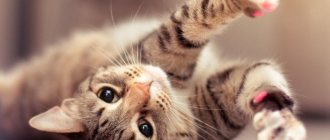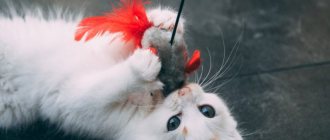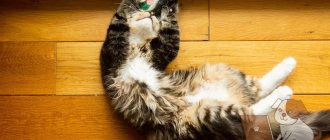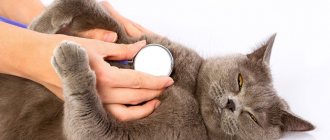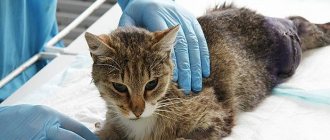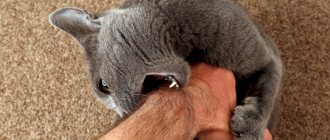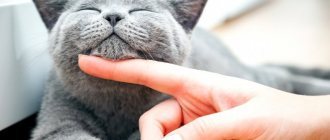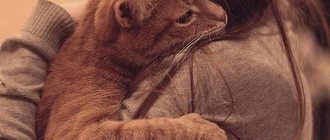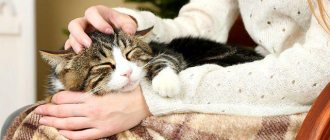It is impossible to resist the charm of a pet when it rolls over on its back and looks at you with big, soulful eyes. What could be cuter than his fluffy belly? It seems that this pose was given to the cat by nature specifically in order to make a person admire and be touched.
After taking a photo of your adorable pet and reaching out to pet its belly, you suddenly find its teeth and claws digging into your hand. A second - and the cute fluffy turns into a wild cat. Such rapid changes in the behavior of the animal cause bewilderment among their owners.
The motives that cause a cat to roll over are different. Knowing them, you can predict its reaction to human affection - whether the animal will receive pleasure or respond with aggression. Below are reasons why your pet may lie on its back. By studying them, misunderstandings can be prevented.
Pose of trust
The abdomen is one of the most sensitive parts of a cat's body, where most of the vital organs are located. Therefore, in times of danger, the animal will primarily protect this area and head.
A pet lying on its back, exposing its belly, demonstrates submission and trust. Signs of insecurity also include splayed hind legs, a relaxed tail, and a calm gaze. In this state, the cat may begin to purr, and it will not nervously twitch its tail or run away when trying to pet it.
Adopting a vulnerable position means that the animal feels that there is no threat and gives the owner access to its belly, including for stroking. At this time, it is important to assess the condition of your pet. Calmness after touching is a good sign that can be seen as an invitation to further communication. To justify the trust placed in you, you should interact with your furry friend gently and carefully.
When to worry
Aggressive cat: main causes and solution to the problem
Sometimes sleeping on its back causes the animal to spread its legs wide. Sometimes this is a sign of a serious pathology. A visit to the veterinarian and diagnostic testing are recommended for pets with the following symptoms:
- unreasonable anxiety, increased irritability;
- searching for secluded places or demonstratively drawing attention to one’s own person;
- frequent and loud meowing in an unusual tone;
- refusal to eat or independently reducing portions to minimum sizes;
- frequent trips to the toilet to empty the bowels or bladder;
- prolonged absence of urination or bowel movements;
- elevated temperatures.
Frequent trips to the toilet are the first sign that something is wrong with the animal.
Apathy and indifference to external stimuli are dangerous signs that indicate the active activity of pathogenic microflora in the body of cats. In some cases, the problem is associated with helminths and intoxication of the body from their waste products.
Possible diseases
There are a number of pathologies that lead to unusual postures in animals. Common diseases:
- poor functioning of the digestive tract - allergic reactions to cheap food, poisoning with stale food, foreign objects entering the gastrointestinal tract, intestinal parasites can cause pain in the gastrointestinal tract. Diseases may be accompanied by attacks of vomiting and diarrhea;
- diseases of the genitourinary tract. Inflammatory processes lead to problems with the free release of the bladder, the appearance of particles of blood, pus, and sand in the urine. The cat is lethargic, when urinating he has a forced, tense posture, he often twitches his hind legs, trying to facilitate the process;
- Heart diseases appear when affected by a viral or fungal infection, poisoning with salts of heavy metals, in stressful situations, and with anemia of various origins. The problem can be identified by heavy breathing with whistling, severe shortness of breath with minimal physical exertion, a drop in temperature, and pallor of the visible mucous membranes. There is no cough due to cardiac pathologies;
- neoplasms are tumors in internal organs and mammary glands, which can be of malignant or benign origin. Their gradual growth interferes with the full functioning of the digestive tract and forces cats to take a forced position on their back. Animals quickly lose weight, become apathetic, refuse to contact people, an enlarged formation on the mammary glands forces the pet to spread its paws wide, as it interferes with normal walking.
If the above signs appear, there is no need to self-medicate and diagnose your sick pet. Attempts to palpate the abdomen will lead to severe aggression with scratching and biting. Diagnostics in a veterinary clinic will help to recognize the ongoing pathological process and find the best method of therapy.
Evil intent
Sometimes a cat is forced to lie on its back by “insidious thoughts.” A sudden jump to the floor can signal that the animal is angry, so before approaching, you should try to read what her body is “saying.”
The tail is a reliable indicator of a cat's mood. Quick movements from side to side signal an increased level of activity: it is time for play (but not for petting). Some pets manage to place their tail between their paws and on their stomach to use it as a built-in toy.
A cat's eyes can tell a lot about the mood of the owner . A glittering gaze following your every move indicates that you have become a target. At this time, the cat's paws begin to twitch and you can see how the animal tries to make several tentative movements towards the intended prey. Active behavior is accompanied by purring or a series of short sounds - this is how the cat lures you.
You should avoid touching an animal lying on its back and intending to play. It is better to postpone attempts to scratch the tummy until later, and instead bring a toy (a stick or a soft object) and, after teasing your pet, watch how he playfully releases his claws.
Features of cat sleep
Every average nine-year-old cat slept for at least six years! However, “overslept” is a rough definition, more like dozed off. Cats allow themselves sound, healthy sleep much less often; they spend most of their lives in the relaxation stage.
Video - How and where cats prefer to sleep
Sleep phases
Table 1. Physiological changes in different stages of sleep
| Criterion | Slow phase | Fast phase |
| Heart | Reducing heart beats | Increased heart rate, pulse may be uneven |
| Lungs | Slowing down your breathing rate | Breathing rate is variable |
| Muscles | Muscle relaxation | Convulsive movements of the tail, paws, twitching of the ears |
| Eyes | Slow fading eye movements occur under the eyelids | Rapid eye movement |
| Body temperature | Decreases (to several degrees) | Increasing |
| Arterial pressure | Decreases | Increasing |
During half-sleep, pets do not cut off contact with the outside world, but continue to receive a continuous stream of information about what is happening around them. This feature is reflected in the position they choose to rest. If we take a closer look at the position of the entire body, we will notice that in most cases the animal takes a “on the alert” position. This means that if an irritant appears, the cat is ready to jump up sharply, and then either run away or attack.
Behind the cat's apparent relaxation, combat readiness is sometimes hidden.
Light, short sleep helps predators quickly regain strength for a short period of time to do intense work before the next period of slumber.
It is impossible to stay on constant “recharging”, so cats plunge into a healthy and sound sleep at a certain moment for the full restoration of the entire body, in particular the immune system. In this case, cats do not immediately wake up in full mobilization of strength.
A cat may unexpectedly end up on its back while sleeping
You can tell that the cat didn’t just close his eyes for five minutes, but fell asleep fully by his posture. It happens that a cat falls asleep in a half-curled position, but over time it begins to toss and turn and ends up on its back, with its paws tucked or spread out. Lying with his eyes closed in this position, the cat is not just dozing - he is completely relaxed and immersed in deep sleep, being completely indifferent to external stimuli.
Relaxation
Each member of the cat family has a favorite sleeping position. Some people prefer to curl up into a ball, while others prefer to stretch out on their sides. There are individuals for whom there is nothing more relaxing than lying on their back.
Sometimes cats fall asleep on their side, and when an “unconscious” state occurs, they roll over onto their back. It happens the other way around: while resting in a belly-up position, the animals feel so good that they begin to doze off. No matter when your furry friend ends up on his back, this position always causes affection.
It is usually quite easy to understand that your pet is resting while lying on its back: its paws are relaxed, its eyes are closed, its breathing is slow, and you can even hear quiet snoring.
Trying to wake a cat often provokes an aggressive reaction, even if it is resting in a protected position. Being in a vulnerable position (with its belly exposed), the animal will wake up and begin to defend itself. It is better not to disturb a pet sleeping on its back at all, but to postpone communication until it wakes up.
What does it mean if a cat sleeps on its back?
A cat's tummy is the most vulnerable and sensitively protected part of the body. Mustached pets avoid his stroking at the level of reflexes, so a very small part of them do not resist the caresses of their owner.
After falling asleep, defenselessness increases. Knowing this, the animals arrange themselves in a ball or “loaf” in advance, minimizing the number of zones for a possible attack. But there are exceptions due to one of the reasons listed below.
INTERESTING!
Cats spend most of their time “recharging” in a state of dozing, immediately reacting to any suspicious rustle.
Trusts
In safe conditions, mustachioed pets instinctively roll over onto their backs out of simple convenience. The love for this position comes from childhood, when a mother cat would turn her babies over and lick their bellies before bed. Such washing not only stimulated intestinal motility, but also relaxed.
If your pet often falls asleep in a similar position next to you, then he trusts you infinitely and is not afraid of a sudden attack. It's not easy to earn this attitude, so you can be proud of yourself.
He's feeling hot
Another reason is high room temperature. An open belly and legs spread out to the sides speed up the cooling process.
In hot weather, animals try to sleep on tiles or the ground. Their breathing rate also increases, because the evaporation of saliva contributes to a faster decrease in body temperature.
Like humans, cats have sweat glands in completely hairless or almost hairless areas. The catch is that there are only 2 of them: the muzzle and the paw pads. Because of this, wet prints often appear on the floor in hot weather.
INTERESTING!
Thick fur impairs natural cooling. Because of this, cats with long hair and dense undercoat most often roll over onto their back.
Relieves pain
In case of health problems, the sleep position in question becomes forced. It relieves discomfort in the following conditions:
- arthritis (pressure on the paws decreases);
- headaches (blood flow to the brain is normalized by stretching the spine in a straight line);
- diseases of the gastrointestinal tract and banal overeating (the load on the stomach decreases).
If the reason lies in stomach pain, then any touch for the purpose of inspection can result in aggression on the part of the disturbed animal. In this case, you should contact your veterinarian.
Ready for love
When a female lays on her back during estrus, this may be a demonstration of her readiness to mate, especially if a male cat is nearby. The “love mood” is also confirmed by intense loud sounds and the desire to sneak out of the house. This behavior is not typical for sterilized individuals; If this is your case, then when you see a cat lying on its back, you should not worry that it is waiting for love.
During estrus, the female is more sensitive and unpredictable, so you should not disturb her belly by touching - this will cause irritation and even aggression (the animal may scratch or bite). It's best to put off tummy rubs until your cat is in heat and calmer.
Cat pose when sick
A healthy cat behaves freely - walks, runs, jumps, lies, sits. A sick pet tries to behave as usual, but experiences pain or discomfort.
These sensations force the sick cat to take the body position in which discomfort and pain are least noticeable. This position is not always unnatural, but when a cat is in pain, the animal has a constant need to take just such a position.
Sometimes the disease manifests itself differently. For example, at elevated temperatures, a cat tries to retire, hide, so as not to be disturbed. He lies down with his front paws tucked under him and “ruffles up.”
But for both options it is typical that the cat is in a state of tension. This is evidenced by the cat's arched (hunched) back and belly, tucked in the direction of the spine.
Self-defense
The cat does not show its belly if it senses danger. However, at times she lies on her back, thereby demonstrating her vulnerability, but in reality, luring the victim. Anyone who falls for this trick and comes closer will be grabbed by all four paws.
If your furry friend lays down on his back immediately after an unpleasant incident, such as waking up suddenly or encountering a dog, he is likely not in the mood to receive belly rubs. Touching at this moment can provoke aggression. A twitching or fluffed tail indicates a state of dissatisfaction.
Other signs of a cat's indignation and anxiety include withdrawn ears, widened or sparkling eyes, and threatening sounds (hissing, growling). If such warning behavior is present, it is best to leave the pet alone, allow it to calm down, and return to socializing at a more appropriate time.
Based on materials from catcheckup.com
The main reasons why a cat lies on its back
The origins of habits must be sought in childhood. From birth, kittens get used to the fact that their mother carries out hygiene procedures, paying special attention to the surface of the child’s belly. A cat licks babies not only to keep their fur clean, but also to prevent digestive problems, since newborns have a poorly developed gastrointestinal tract.
An obese cat is no joke
A grown adult retains memories of favorite childhood moments, and sleeping in a relaxed position helps calm the nervous system. And if an older cat sleeps with its owner on its back, with its paws outstretched, then in this way it subconsciously seeks a replacement for its mother cat and protection from external irritants in its face.
For your information! Chinese wisdom says that only the righteous and kings can sleep on their backs. This statement can be transferred to furry pets - a royal person should not experience discomfort while resting.
Convenience and comfort
Trying to sleep with your belly up indicates bliss and complete satisfaction with life. Bizarre curves and sound sleep are not a reason to look for hidden meaning or call a veterinary ambulance. This position is simply convenient, and you should not change it by forcibly turning your pet into the correct position.
Important! It has been observed that the cat lies on its back in its house or box to achieve the most comfortable conditions. The couch potato can stretch, wriggle and return to a comfortable body position.
Trust in the owner
Why does a domestic cat lie on its back in front of its owner under normal conditions:
- feels well, is not bothered by illnesses;
- completely trusts its owner;
- He doesn’t think there could be any danger in his apartment.
Experienced breeders are confident that this position communicates the warmest possible relationship between the cat and the owner, and the pet’s love for its owner. If a cat lies on its back, raises its paws up and stretches sweetly, then with these movements it shows the highest degree of trust. It is very difficult to earn such an attitude from an animal.
Important! You should not assume that this cat behavior is an invitation to affection. When trying to stroke the belly during sleep or shake a limp animal, you can get hit with a paw with extended claws. A sleepy pet acts instinctively, and the only culprit in an urgent problem is the owner.
Binge eating
Animals that rarely leave the apartment or have been sterilized suffer from uncontrolled gluttony. The problem is the lack of necessary physical activity and the constant desire to beg, steal or demand an additional bowl of food. The pity of the owners leads to systematic overeating and digestive problems.
Habits do not depend on breed
After the next portion of food, the pet feels the need to rest. He cannot lie on his stomach, as unpleasant sensations arise. As a result of an overfilled stomach, he will have to take a forced position, tuck his limbs, as long as nothing puts pressure on the stomach and intestines.
From a distance, it seems that the cat is simply lying on its back, although at this moment the furry pet is having difficulty digesting the excess food. The problem of gluttony is acute and requires the owner to correctly calculate portions, use balanced feed, and feed no more than 2-3 times a day.
Cats prefer unusual body positions for many different reasons. Common ones include:
- puberty or mating season. A healthy pet that has not been spayed or neutered periodically feels discomfort in the groin area. The cat is forced to lie on its back to reduce discomfort;
- hot weather. An open belly and a gentle breeze help you cool down faster. That is why animals prefer to move from a comfortable sofa to an uncarpeted floor or tile in the heat;
- weather changes. Not only the adult, but also the young animals feel the imminent change in temperature. Increased sensitivity helps felines survive in the wild. The pet also reacts to changes: when it is hot, it lays down with its belly up; when it gets cold, it prefers to curl up in a ball, tucking its paws under itself;
- pregnancy. Bearing offspring is a complex process. Multiple pregnancies and large kittens actively put pressure on internal organs and interfere with the functioning of the respiratory system.
When you place your palm on the abdominal wall of the expectant mother in the last stages, you can feel the babies moving. Folk omens say that sleeping on the cat's back foretells large cubs or an unprecedented number of offspring.
